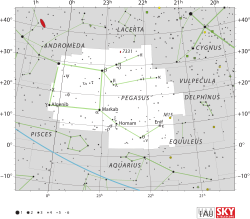
Back سعد البهام Arabic Baham (estrella) AST Baham Catalan Biham (Stern) German Baham (estrella) Spanish تتا پگاسوس Persian Theta Pegasi French Theta Pegasi ID Theta Pegasi Italian ペガスス座シータ星 Japanese
| Observation data Epoch J2000.0 Equinox J2000.0 | |
|---|---|
| Constellation | Pegasus |
| Right ascension | 22h 10m 11.98528s[1] |
| Declination | +06° 11′ 52.3078″[1] |
| Apparent magnitude (V) | +3.52[2] |
| Characteristics | |
| Evolutionary stage | main sequence[3] |
| Spectral type | A2V[4] + M4-5.5[5] |
| B−V color index | 0.086±0.002[2] |
| Astrometry | |
| Radial velocity (Rv) | −7.9±2.4[2] km/s |
| Proper motion (μ) | RA: +282.18[1] mas/yr Dec.: +30.46[1] mas/yr |
| Parallax (π) | 35.34 ± 0.85 mas[1] |
| Distance | 92 ± 2 ly (28.3 ± 0.7 pc) |
| Absolute magnitude (MV) | 1.24[2] |
| Orbit[5] | |
| Semi-major axis (a) | 6.55+3.0 −0.48 au |
| Eccentricity (e) | 0.54+0.28 −0.15 |
| Inclination (i) | 66.7+8.5 −14° |
| Details | |
| θ Peg A | |
| Mass | 2.09 ± 0.16[6] M☉ |
| Radius | 2.623±0.083[5] R☉ |
| Luminosity | 23.7±1.1[4] L☉ |
| Surface gravity (log g) | 3.95[6] cgs |
| Temperature | 7872±82[4] K |
| Metallicity [Fe/H] | −0.38[4] dex |
| Rotational velocity (v sin i) | 136[6] km/s |
| Age | 448[6] Myr |
| θ Peg B | |
| Mass | 0.280+0.18 −0.059[5] M☉ |
| Surface gravity (log g) | 5.5[5] cgs |
| Temperature | 3200[5] K |
| Other designations | |
| Database references | |
| SIMBAD | data |
θ Pegasi, Latinized as Theta Pegasi, is a single[8] star in the equatorial constellation of Pegasus, lying about 7.5 degrees southwest of Enif.[9] It has the traditional name Biham /ˈbaɪ.æm/,[10][11] and the Flamsteed designation 26 Pegasi. This object is visible to the naked eye as a white-hued point of light with an apparent visual magnitude of +3.52.[2] The system is located 92 light years from the Sun based on parallax, but is drifting closer with a radial velocity of −8 km/s.[2]
This object an A-type main-sequence star with a stellar classification of A2V.[4] It is 448[6] million years old with a high rate of spin, showing a projected rotational velocity of 136 km/s.[6] This star has 2.09[5] times the mass of the Sun and 2.6[12] times the Sun's radius. It is radiating 25 times the luminosity of the Sun from its outer envelope at an effective temperature of 7,951 K.[12] The star appears to display a slight infrared excess.[13]
θ Pegasi was suspected of being a binary star due to an acceleration detected by Hipparcos. In 2021, a low-mass companion star was discovered, associated with θ Pegasi.[5] It is a red dwarf with a spectral type of M4 to M5.5, and a luminosity of 0.5% that of the Sun.[5] The orbit around the primary is estimated to be moderately eccentric, at 0.54, and has a semimajor axis of 6.55 au.[5]
- ^ a b c d e Cite error: The named reference
van Leeuwen2007was invoked but never defined (see the help page). - ^ a b c d e f Cite error: The named reference
Anderson2012was invoked but never defined (see the help page). - ^ Cite error: The named reference
zorec2012was invoked but never defined (see the help page). - ^ a b c d e Cite error: The named reference
apj771_1_40was invoked but never defined (see the help page). - ^ a b c d e f g h i j Steiger, Sarah; et al. (2021). "SCExAO/MEC and CHARIS Discovery of a Low-mass, 6 au Separation Companion to HIP 109427 Using Stochastic Speckle Discrimination and High-contrast Spectroscopy". The Astronomical Journal. 162 (2): 44. arXiv:2103.06898. Bibcode:2021AJ....162...44S. doi:10.3847/1538-3881/ac02cc. S2CID 244399987.
- ^ a b c d e f Cite error: The named reference
David2015was invoked but never defined (see the help page). - ^ Cite error: The named reference
SIMBADwas invoked but never defined (see the help page). - ^ Cite error: The named reference
DeRosa2014was invoked but never defined (see the help page). - ^ Cite error: The named reference
Mollise2012was invoked but never defined (see the help page). - ^ Cite error: The named reference
Kunitzschwas invoked but never defined (see the help page). - ^ Cite error: The named reference
IAU-CSNwas invoked but never defined (see the help page). - ^ a b Cite error: The named reference
apj746_1_101was invoked but never defined (see the help page). - ^ Cite error: The named reference
Nuñez2017was invoked but never defined (see the help page).
